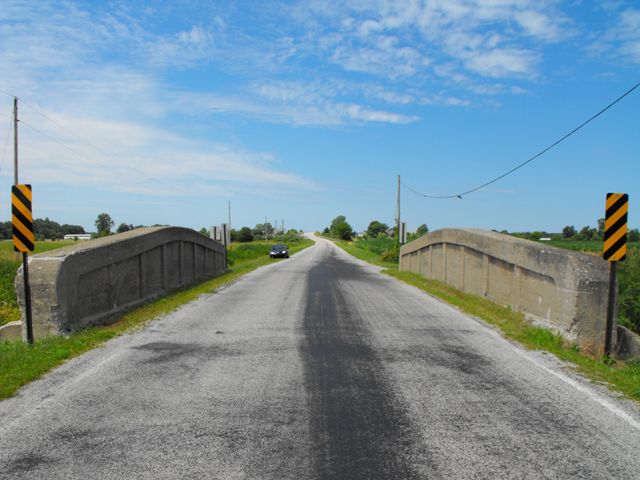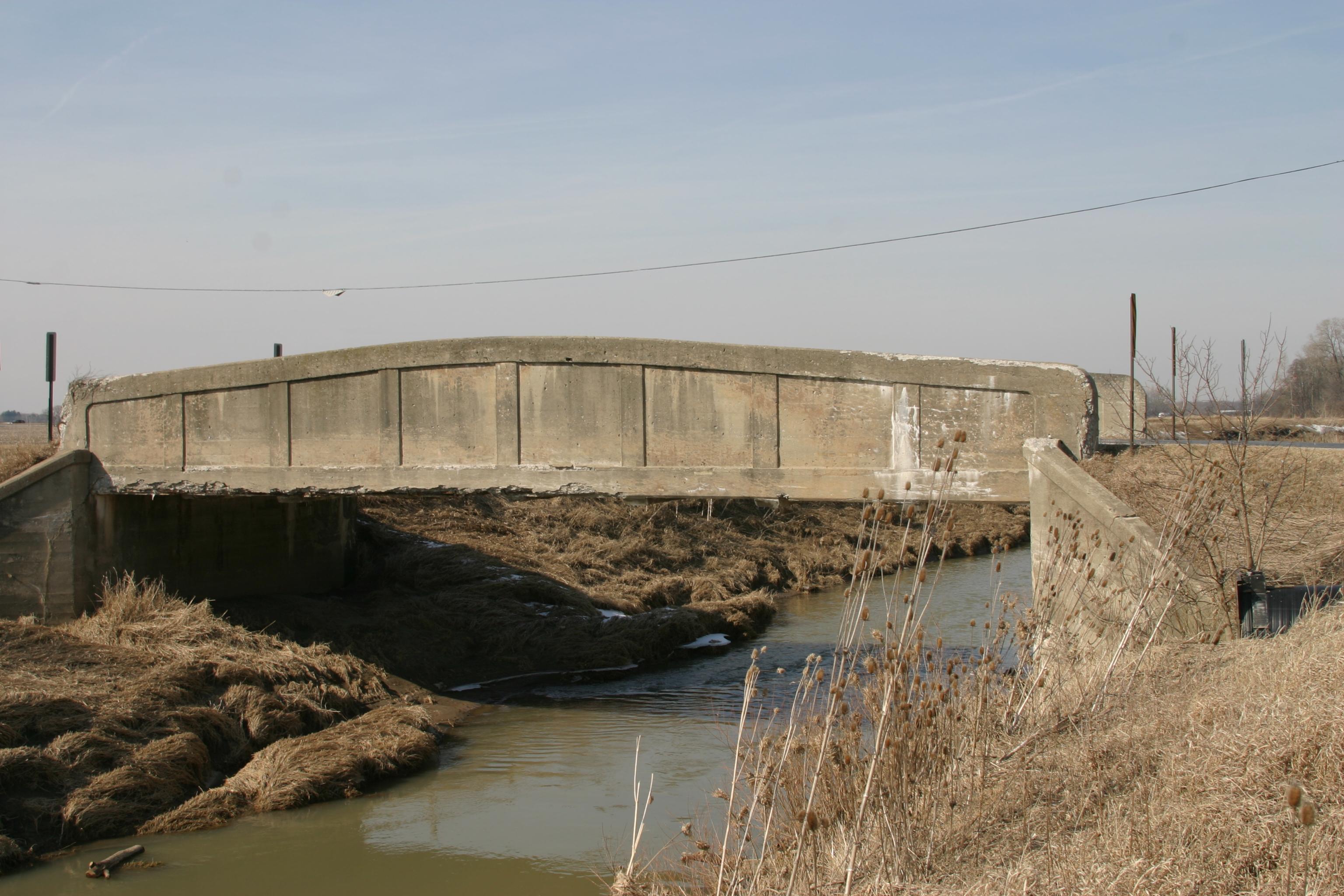We Recommend:
Bach Steel - Experts at historic truss bridge restoration.
Mermill Road Bridge

Primary Photographer(s): Nathan Holth and Rick McOmber
Bridge Documented: March 9, 2007 and July 8, 2009
Rural: Wood County, Ohio: United States
Not Available or Not Applicable
58.0 Feet (17.7 Meters)
60.0 Feet (18.3 Meters)
23.3 Feet (7.1 Meters)
1 Main Span(s)
8738858

View Information About HSR Ratings
Bridge Documentation
This bridge no longer exists!
View Archived National Bridge Inventory Report - Has Additional Details and Evaluation
Although their appearance is quite different, this bridge functionally appears to be based on the ideas behind the unique concrete curved chord through girder bridges designed and built in Michigan. The design was simple, yet it was not known to be built widely outside of Michigan's borders. Ohio is an exception however and it has a number of remaining concrete curved chord girders, however. The design essentially consisted of taking the standard concrete girder bridge and adding an arch shape to the girders. This was likely done to increase strength, improve efficient use of materials, and enhance the physical appearance of the structure. Although the Mermill Road Bridge does not feature a highly defined curve, the idea behind having the girder taller in the center suggests the thinking was the same when this bridge was constructed. In addition, the 1925 construction date of this Ohio bridge is right at the same time these bridges were being built in Michigan.
The bridge has not been maintained and is in poor condition. There are numerous cracks in the concrete. In addition, the deck was overlaid with asphalt which trapped moisture in the concrete deck. Further, dirt has been allowed to gather at the edges of the roadway on the deck and grass is now growing. This all indicates improper maintenance. Now, Wood County wants to demolish this historic bridge.
The below photos were provided by Ohio Department of Transportation and they show detail under the bridge, an angle that was not accessible during HistoricBridges.org's documentation of the bridge. The photos reveal that the deterioration is also underneath the bridge in the form of efflorescence and cracking.
Information and Findings From Ohio's Historic Bridge InventorySetting/Context The bridge carries a 2 lane road over a stream in a sparsely developed, rural setting. Physical Description The one span, 60'-long, reinforced concrete thru girder bridge with articulated floorbeams is supported on concrete abutments. The girders are shaped. Summary of Significance The 1925 thru girder bridge is an undistinguished example of a standardized bridge type in use from the mid 1910s to 1930s. It is not technologically significant. Reinforced-concrete thru girder bridges are
composed of a pair of cast-in-place longitudinal girders and transverse floorbeams or deck slab (the former is the case with most Ohio examples) that are connected by the arrangement of the steel reinforcing bars. The roadway passes
between the paired girders, which are the main supporting members and also serve as railings. The girders are commonly very large in appearance (18" to 30" wide and 4' to 6' deep) and have deep panels to save on weight. The depth of
the girders is related to span length with the longer the span the greater the depth. In many cases, the girders are shaped to achieve the greatest depth of beam at mid-span where it is required to support the design moments
(stresses). The shaped girder is a design detail to accommodate longer and/or wider spans and/or heavier design loads, it is not aesthetic. Bridge Considered Historic By Survey: No |
![]()
Photo Galleries and Videos: Mermill Road Bridge
2009 Bridge Photo-Documentation
Original / Full Size PhotosA collection of overview and detail photos, taken July 8, 2009. This gallery offers photos in the highest available resolution and file size in a touch-friendly popup viewer.
Alternatively, Browse Without Using Viewer
![]()
2009 Bridge Photo-Documentation
Mobile Optimized PhotosA collection of overview and detail photos, taken July 8, 2009. This gallery features data-friendly, fast-loading photos in a touch-friendly popup viewer.
Alternatively, Browse Without Using Viewer
![]()
2007 Bridge Photo-Documentation
A collection of overview and detail photos, taken March 9, 2007. This photo gallery contains a combination of Original Size photos and Mobile Optimized photos in a touch-friendly popup viewer.Alternatively, Browse Without Using Viewer
![]()
Maps and Links: Mermill Road Bridge
This historic bridge has been demolished. This map is shown for reference purposes only.
Coordinates (Latitude, Longitude):
Search For Additional Bridge Listings:
Bridgehunter.com: View listed bridges within 0.5 miles (0.8 kilometers) of this bridge.
Bridgehunter.com: View listed bridges within 10 miles (16 kilometers) of this bridge.
Additional Maps:
Google Streetview (If Available)
GeoHack (Additional Links and Coordinates)
Apple Maps (Via DuckDuckGo Search)
Apple Maps (Apple devices only)
Android: Open Location In Your Map or GPS App
Flickr Gallery (Find Nearby Photos)
Wikimedia Commons (Find Nearby Photos)
Directions Via Sygic For Android
Directions Via Sygic For iOS and Android Dolphin Browser
USGS National Map (United States Only)
Historical USGS Topo Maps (United States Only)
Historic Aerials (United States Only)
CalTopo Maps (United States Only)





